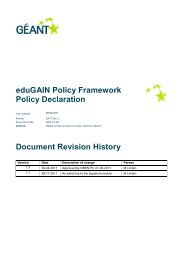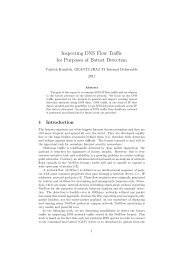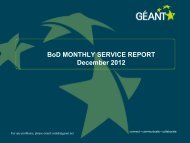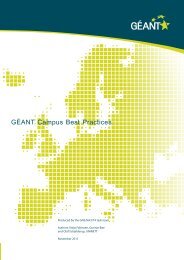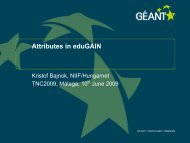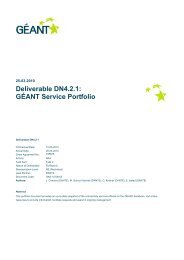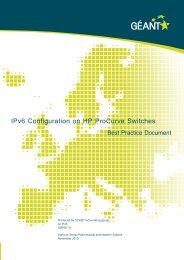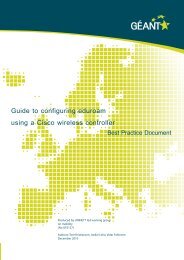TERENA COMPENDIUM - Géant
TERENA COMPENDIUM - Géant
TERENA COMPENDIUM - Géant
Create successful ePaper yourself
Turn your PDF publications into a flip-book with our unique Google optimized e-Paper software.
<strong>TERENA</strong> Compendium of National Research and Education Networks In Europe /Users/Clients2 USERS/CLIENTSThis section starts with information in section 2.2 about the connection policiesof NRENs (i.e., who is allowed to connect). Section 2.3 provides an indication ofwhat proportion of the total access capacity that is available to an NREN is usedby various user categories. The last sections look more closely at the bandwidthof universities and at the percentage of schools that are connected throughNRENs. Note that the Compendium website contains additional information.More information about European educational systems in general can be foundat http://www.eurydice.org.The 2005 edition of the Compendium contained an overview of Acceptable UsePolicies of NRENs. Because these policies do not change much over time, theinformation is not repeated this year. Information on NREN AUPs can be found onthe Compendium website.The overview section (2.1) gives aggregate data and tries to identify trends in allof these areas.2.1 OverviewConnection PoliciesTable 2.2.1 gives an overview of which types of institutions can be connected tothe NREN (the Connection Policies).As is clear from the table, all NRENs can connect universities, researchinstitutes and, with four exceptions, institutes of higher education. For otherinstitutions, there are great differences in policy between NRENs. Notethat sometimes there are further restrictions, not included in the table. Forexample, some NRENs only connect government departments that have arelation to research and education.For more details on individual NRENs, please consult the country entries on thewebsite or the NREN websites themselves.In the EU/EFTA countries, on average more than 80% of the access capacity isused for the tertiary education sector.NRENs are quite diverse when it comes to methods of connecting institutions.Indeed, reference to previous Compendia shows that this has changed very littlein recent years.Bandwidth of UniversitiesLooking back five years, there is a clear trend in the bandwidth of universities.In 2003, the ‘average’ university was connected at Megabit capacity; by 2008,that had changed to Gigabit capacity.This trend is less pronounced, in the countries outside of the EU/EFTA area.It should be noted that increases are usually not gradual, but occur in steps,with the introduction of new technologies.For institutions other than universities, it is reasonable to expect thatcapacities will have increased as well. Yet most secondary and primaryschools are not (yet) connected at Gigabit capacities.Connections to Primary and Secondary SchoolsFor a while, the expectation was that the number of connections by NRENsto primary and secondary schools would increase from year to year. Thisseems not to have happened – instead, the situation seems to be more orless stable overall. This is due not so much to the fact that connections toprimary and secondary schools are not considered important, but rather todifferences in national policies. In some countries, it has been decided thatthese connections should be a task of the NREN – and this is shown in the23



